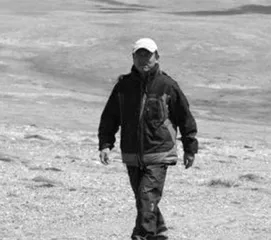保护野骆驼,从卫星定位开始
作者: 孙启禄

在遥感科学家刘少创的办公室里,有一张他十年前蹲守在新疆戈壁滩上拍摄的野骆驼的巨幅照片。
主题语境:野生动物保护篇幅:360词建议用时:7分钟
In the office of remote sensing scientist Liu Shaochuang, there is a huge photo of awild camel he took a decade ago. He crouched (蹲) for hours by a pool of water in the GobiDesert to take the photo. This is the subject of his research.
Living in the harsh deserts in northwestern China and southwestern Mongolia, thewild camel is listed as critically endangered by the International Union for Conservation ofNature. The population of this species is currently less than 1,000, of which around 650are in China.
Because wild Bactrian camels are fully migra⁃tory and can travel over long distances, scientistsused to learn their habits by studying hoof (蹄) printsand droppings. It was hard to find one camel in thedesert, let alone track it. But, Liu thought his exper⁃tise in satellite navigation and remote sensing mightbe useful in the study of wild camels.
It was not easy at first. His team had to spend several weeks each year braving dustand sandstorms in the Gobi Desert seeking out camels.“The most thrilling moment was at⁃taching (系上) trackers to the wild camels,”Liu recalls. On May 6, 2012, Lius team, forthe first time, succeeded in putting a satellite positioning collar on a wild camel in the LopNur Desert.
The tracking collar, equipped with special receivers, weighs only a few hundredgrams. It can detach (拆卸) automatically and will not have a negative influence on thedaily lives of the animals. According to Liu, at least seven wild camels are currently fittedwith tracking collars, and their locations are transmitted via satellites every day. Based onthe tracking data, scientists can get to know their migratory paths, living environments andpossible threats they may experience.
Lius latest discovery is that the suitable habitat range has shrunk greatly due to cli⁃mate change, and that wild camels have moved to the colder Altun Mountain Range inChina, and higher⁃altitude regions in Mongolia as a result.“They face more dangers,”Liusays.“For example, the narrowing habitats may lead to an increased chance of attacks bywolves, a reduction in drinking water and a higher risk of disease.”
1. What can be inferred about the wild camel from paragraph 2?
A. It lives in southeastern China.
B. It reacted violently to remote sensors.
C. It has a large population globally.
D. It can be seen mostly in China.
2. Which of the following is the most exciting according to Liu?
A. Studying wild camels hoof prints.
B. Taking photos of wild camels droppings.
C. Putting trackers on wild camels.
D. Finding one wild camel in the desert.
3. Whats paragraph 5 mainly about?
A. Sandstorms in the Gobi Desert.
B. The tracking collars usefulness.
C. Lius measures to protect wild camels.
D. Threats that wild camels may experience.
4. Whichwordcanreplacetheunderlinedword“shrunk”inparagraph 6?
A. Reduced. B. Improved.
C. Survived. D. Changed.
Ⅰ. 日积月累
endangered adj. 濒危的
currently adv. 目前
migratory adj. 迁徙的
track v. 追踪
thrilling adj. 激动人心的
be listed as 被列为……
let alone 更别说
seek out 找出
attach...to 把……附在……上
succeed in doing 成功做……
satellite positioning collar 卫星定位项圈
have a negative influence on 对……有负面影响
due to 由于
as a result 结果
Ⅱ. 单句填空
1. The wild camel is listed an endangered species.
2. This matter is (current) being discussed.
3. That was really a (thrill) experience.
4. Attach the coupon (优惠券) the front of your letter.
5. He succeeded in (get) a place at art school.
6. Watching TV for a long time has a negative influence childrens health.